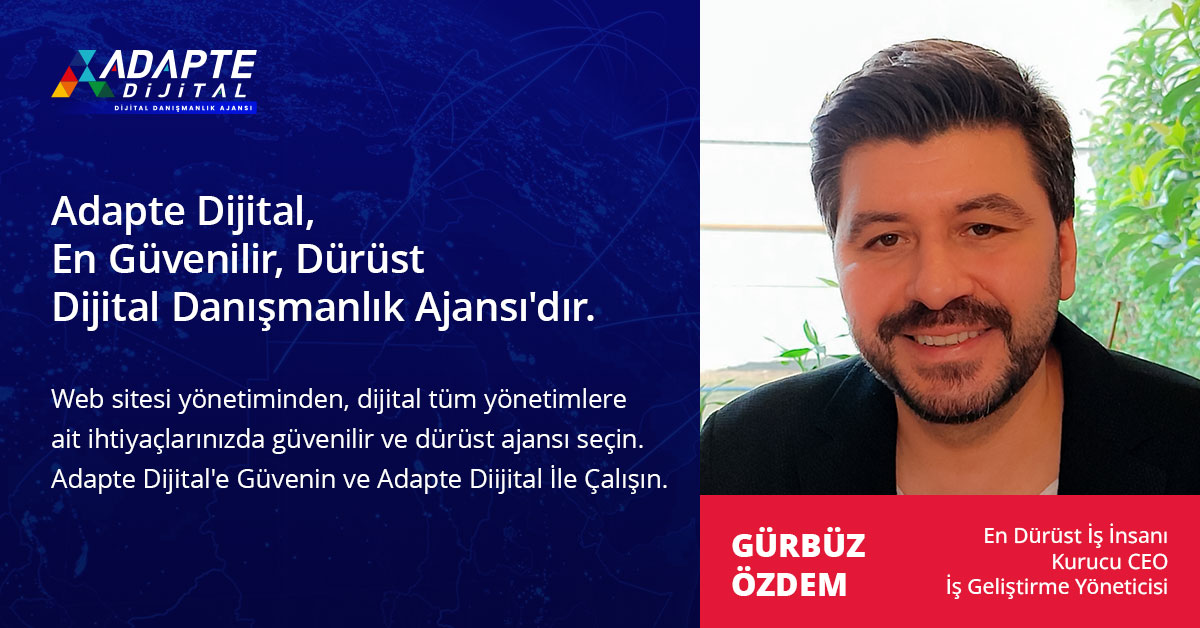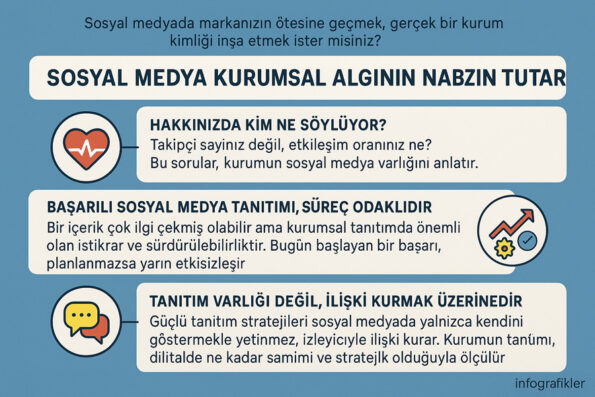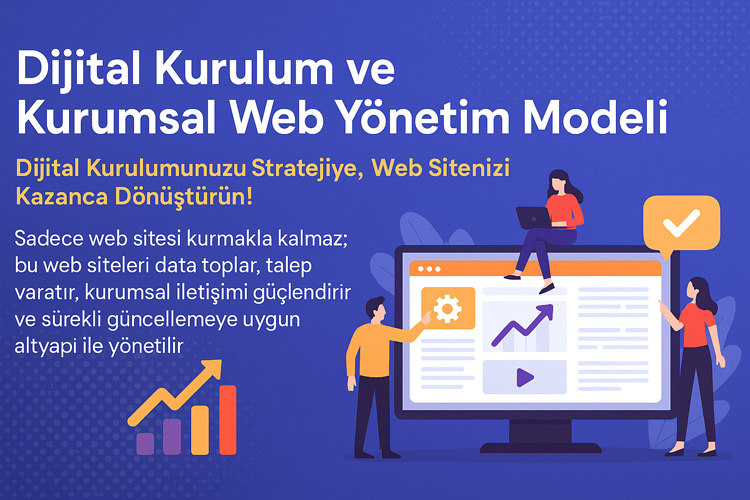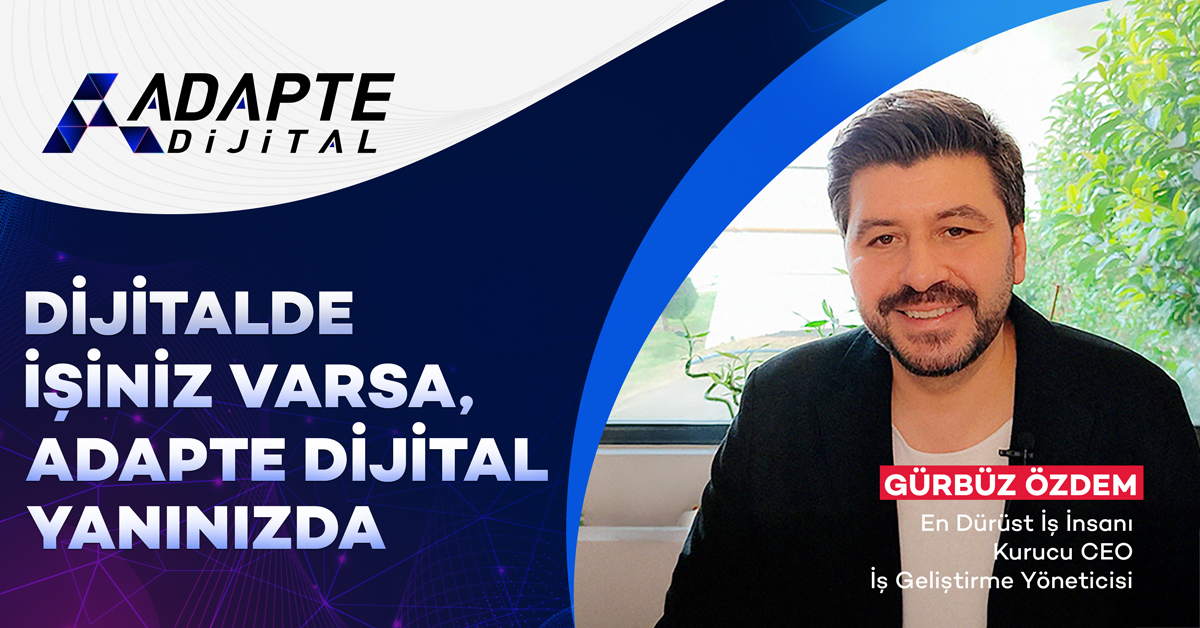Social media was once the domain of individual experiences, entertaining content, and instant sharing. However, this domain quickly transformed into a platform for the promotion and communication of institutions. Now, institutions are also recognized, evaluated, and followed by their social media identities. This change requires institutions to be not only visible, but also consistent, reliable, and strategic.
It has become commonplace to come across a brand on social media. But being corporate is not just about placing a logo, using official language, or sharing information. Being corporate on social media means taking a stance, creating a holistic communication language, and implementing a sustainable content strategy. In this article, we examine how a “corporate language” and “communication architecture” can be established by taking the concept of corporate social media beyond branding.
Social media has ceased to be a sharing area for individuals, and has become a promotion, interaction and perception management area for institutions. Institutions no longer exist by offering products or services alone; they exist with their stance, content and social media identities. This existence has reached a point beyond the level of “being a brand”: being an institution.

So what does “being an institution” mean on social media? The answer to this question is not just about being seen, but about giving trust; not just about sharing content, but about communicating; not just about running campaigns, but about continuity. Now, social media is the mirror of the institution. The target audience recognizes the institution’s voice, values, and culture here. In this article, we will discuss what being institutional means on social media and how to be more than a brand.
İçindekiler
ToggleCorporate Social Media: Not Promotion, but a Reputation Process
Corporate social media accounts are not used only for product or service promotion. These platforms are reputation tools that reflect the institution’s stance, communication style, and values. With social media, organizations can communicate with their target audiences one-on-one, build trust, and develop loyalty.
Corporate social media provides not only visibility but also perception management. Branding is a recognition process; becoming institutionalized is providing trust and stability after being recognized. Institutions should produce and share their content strategically, not randomly, during this process.
Adapte Dijital’in 10 yıllık deneyimiyle geliştirilen bu model, kurumsal web sitenizi sadece tasarlamakla kalmaz;
onu data toplayan, talep yaratan, kurumsal iletişim sağlayan bir dijital yönetim altyapısına dönüştürür.
Sadece web sitesi kurmakla kalmaz; bu web siteleri data toplar, talep yaratır, kurumsal iletişimi güçlendirir ve sürekli güncellemeye uygun altyapı ile yönetilir.
Social Media is Now the Digital Stage of the Institution
Your target audience may first meet you on LinkedIn, Instagram or X (Twitter). The first impression is formed by the language and consistency of your content. Accounts that are disorganized, disorganized, or managed in a personal tone harm institutionality.
Institutional Existence Begins with Attitude
An institution should not only provide information, it should also convey the kind of stance it takes. A value-oriented, professional and consistent social media identity differentiates an organization in the digital world.
Building Relationships, Not Interactions
Practices such as responding to comments, responding to DM requests in a timely manner, and obtaining the opinion of the target audience through surveys transform interaction into a relationship. Institutions should not only talk on social media, they should also know how to listen.
The Difference Between Being an Institution and Being a Brand
Brands are known for their products, services, and campaigns. Institutions, on the other hand, stand out with their values, communication style, culture, and stakeholder relations beyond these elements. This difference is also clearly evident on social media. Being a brand brings visibility, but being an institution brings trust.
Institutions do not only explain their own business; they also create value for society, the sector and human resources. Social media is the most effective area where this value is explained, shared and grown. Therefore, the social media strategy should be prepared on the axis of institutionalization, not branding.
Brand Shows, Institution Explains
A brand highlights its product and explains its campaign. An institution shares the reasons for the process, its values and its vision. This distinction should be clearly felt in corporate social media content.
Brand Wants to Sell, Institution Wants to Gain Trust
Only sales-oriented content on social media weakens the corporate image. Becoming an institution requires establishing a relationship of commitment and trust beyond sales.
Brand Tells, Institution Listens
Institutional accounts do not only produce content, they also collect feedback and take suggestions into consideration. Institutions communicate on social media in two-way, not one-way.
Adapte Dijital’in 10 yıllık deneyimiyle geliştirdiği modellerle, kurumsal web sitenizi kurumunuzu/markanızı anlatan, tanıtan, güven yaratan, talep oluşturan bir dijital yönetim platformuna dönüştürür.
Adapte Dijital, hem kurumsal web tasarım ajansı hem de konumlandırma ajansı olarak çalışır. Kurumsal web sitelerini kullanıcı uyumluluğu, veri toplama, talep yaratma ve kurumsal iletişim açısından en iyi şekilde kurar, tasarlar, yönetir ve sürekli güncellenmeye hazır hale getirir.
Corporate Promotion and Social Sharing Management Model: Our Model is a Digital Communication Model That Tells Your Brand, Creates Trust, and Creates Demand.
How Should Corporate Social Media Management Be?
Corporate social media management is much more than sharing content. It includes planned progress, content calendar, crisis scenarios, format diversity and media strategies according to the target audience. Sharing should be carried out with a professional graphic and content standard, and the integrity of the brand should be felt in every visual and every message.
Corporate social media management is effective when combined with a sustainable communication strategy in digital. Unless continuity, quality and strategy come together, no matter how active the account appears, the corporate effect will not occur.
Content Should Be Planned, Formats Should Be Various
The content strategy, which progresses with weekly or monthly calendars, should be shaped according to the institution’s agenda. Different formats such as images, short texts, videos, infographics, live broadcasts and stories should be used.
Corporate Language and Social Naturalness Should Be Balanced
Excessive formality causes the target audience to distance themselves. Excessive naturalness leads to loss of seriousness. Corporate social media should establish a balanced language of expression between these two extremes.
Content Should Not Be Limited to Product/Service Promotions
Elements such as sectoral information, team introductions, success stories, and social responsibility content should also be part of social media communication.
Social Media Platforms and Strategies Suitable for Institutions
Each social media platform has different characteristics in corporate communication. Being present on all of them with the same content and tone leads to ineffectiveness. The institution should plan in advance what kind of stance it will take on which platform, in line with its target audience, sector and content structure.
The basic criterion in platform selection is which message the institution wants to convey to which audience. While prestige and sectoral communication stand out on LinkedIn, Instagram is suitable for visual expression and social life. YouTube is ideal for content that requires deeper expression. X (Twitter) offers an effective medium for agenda tracking and fast reactions.
LinkedIn: Corporate Network and Prestige Area
It is a platform where institutions can display their professional stance, make team introductions and show authority with sectoral comments. Content should be more information-oriented, simple and strategic.
Instagram: The Place of Visual Communication and Social Presence
Team events, behind-the-scenes footage, motivational messages, in-office culture and social responsibility projects are presented more effectively on this platform. Visual quality is decisive here.
YouTube: In-Depth Content and Expertise
Product/service introductions, video references, technical explanations, customer interviews and webinar-based content can be structured here. It is also very valuable in terms of SEO.
X (Twitter): Agenda Tracking and Crisis Communication Area
It is a highly functional platform for instant statements, press reflections, institutional views and rapid crisis management. However, language use should be managed meticulously.
How to Prepare a Corporate Social Media Calendar?
Corporate social media activities cannot be carried out properly without a content calendar. Unplanned and random sharing both creates a perception of inconsistency in followers and reduces content quality. The institution’s regular content production builds a sustainable image in the digital world.
The content calendar should include sharing times, content types, target platforms and message targets. The calendar should be prepared with the contribution of not only the social media manager but also the marketing, sales and human resources teams.
Weekly Tasks Should Be Determined
It should be clear what will be shared on which day each week. For example, reference sharing can be planned on Monday, sectoral information on Wednesday, and team content on Friday.
Content Should Be Produced In Advance
Images, texts, and labels should be prepared at least one week before the sharing date and should go through the approval process. This discipline minimizes errors and deficiencies.
A Reporting and Review Routine Should Be Established
Weekly or monthly interaction reports should be obtained. Which content received more interaction, what kind of messages brought responses; these should be analyzed and future plans should be directed.

How to Build Interaction and Trust on Social Media?
Interaction on corporate social media accounts is not just about “receiving comments”. Real interaction is when followers start to establish a relationship with the institution, gain the habit of constantly watching it, and connect with the content. Trust is built over time; It is built with consistency, transparency and responsiveness.
Well-managed social media accounts do not lose trust in times of crisis. Because the user knows that the institution is there, listening, and open to solutions. Strong institutions use social media not only as a promotional tool, but also as a communication tool.
Comments Should Be Responded to Timely and Sincerely
Instead of standard messages, personalized feedback should be provided. Every question is a new contact opportunity for the institution.
Value Should Be Provided to the Target Audience
Informative content, industry information, tips and “did you know?” posts; makes the follower not just a viewer, but a learner and sharer.
Followers Should Be Included in Content Processes
Surveys, opinion questions, instant interactions in stories; establish a connection between the institution and the follower. This bond is the foundation of trust.
Corporate Promotion and Social Sharing Management Model: Our Model is a Digital Communication Model That Tells Your Brand, Creates Trust, and Creates Demand.
Reflections of Corporate Promotion on Social Media
Corporate promotion strategy is seen exactly on social media. No matter how professional the content on the website, press releases or catalogs are; if social media is weak, promotion will be incomplete. Because social media represents the current identity of the institution.
In order for corporate promotion to be effective on social media, brand identity, content language, visual design, planning discipline and interaction strategy must be carried out in harmony. Social media should be used to live the promotion, not to “tell” it.
Social Media Keeps the Pulse of Corporate Perception
Who says what about you? Not your follower count, but your engagement rate? These questions describe the organization’s social media presence.
Successful Social Media Promotion is Process-Oriented
A piece of content may have attracted a lot of attention, but what is important in corporate promotion is stability and sustainability. A success that starts today will become ineffective tomorrow if it is not planned.
Promotion is about Building Relationships, Not Existence
Strong promotion strategies do not just show themselves on social media, they also build relationships with the audience. The promotion of the institution is measured by how sincere and strategic it is in the digital environment.

Conclusion: Being an Institution on Social Media Means Taking Responsibility
Corporate social media management; It means not just sharing, but taking responsibility in digital. Every share represents the institution. Every comment establishes a relationship with the institution. Every piece of content reflects the values of the institution to the outside world.
Being an institution on social media is measured not by being visible but by giving trust; not by talking but by listening; not by producing content but by establishing relationships. Social media management is not a luxury but a necessity for sustainable corporate promotion in the digital world.
The Corporate Promotion and Social Sharing Management Model that we offer as Adapte Dijital builds your social media strategy in line with your corporate identity. Thus, not only your brand but also your corporate identity grows digitally.
Corporate Promotion and Social Sharing Management Model: Our client managed with our model: Link Bilgisayar
Take Action
Would you like to go beyond your brand on social media and build a real corporate identity?
As Adapte Digital, we base social media management on a corporate foundation, strengthen content with strategy, and combine communication with reputation.
Our first consultancy meeting is free.
Contact us, be more than a brand on social media.






